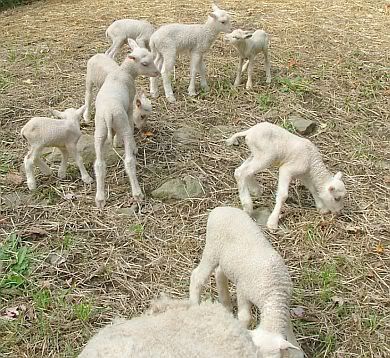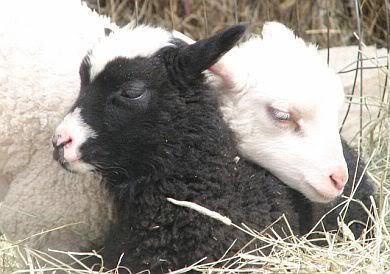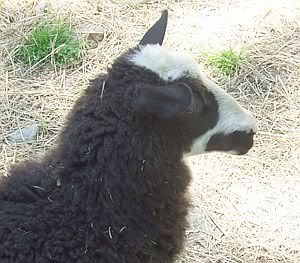
Last Friday it was very cold for our spinners group to meet at the library. We spin downstairs in the finished basement but it can get a little cold when the temps dip below zero. So, Grace Hatton invited us over to her farm where she raises Finnsheep and her husband Fred restores antique spinning wheels. I always enjoy a trip over to their farm.
During my visit, Grace agreed to do a short interview on my blog to share her experience of raising Finnsheep. And she kindly provided me with some photographs to go with the post!
cyndy: Hi Grace! You and I have talked recently about your wonderful Finnlandrace Sheep. You mentioned to me that the breed is in danger of dying out (here in the USA) and certainly losing genetic diversity. How many are in the country at the present time?
Grace: There were only about 340 registered in 2008.
cyndy: Can't you just import some if they go extinct in this country?
Grace: No. There are import restrictions.
cyndy: Oh my, I didn't realize that! How long have you been raising Finnsheep, and why did you choose that breed?
Grace: We have raised registered Finnsheep since 1986. We could not afford to have animals that could not pay their way so the idea that Finnsheep would have litters of lambs was very appealing.
cyndy: Would you speak a little bit about their background?
Grace: They were developed over hundreds of years ago in Finland which is near the Arctic Circle. Winters are very long. It was not practical to keep large numbers of ewes in barns over the winter, but still plenty of lambs were welcome to graze the forages that grew rapidly under the "midnight sun. Some shepherds bred their ewes to lambs twice in one year.
cyndy: I've heard you say that Finnsheep are easy to care for and fun to keep. Why do you think they have such a good temperament?
Grace: Unlike Shetland and Icelandic sheep (their relatives) that were wintered out of doors because there were no predators on Shetland or in Iceland, Finnsheep always lived close to humans. This probably accounts for their gentleness and docility. We have a similar situation here in terms of climate and predation to Finland. Black bears kill our sheep. Bald eagles and coyotes are around, but have not been a problem. yet.
cyndy: I've heard that Finnsheep have a reputation for having more than one lamb at a time. What is the record number of lambs born to one ewe?
Grace: Finnsheep usually have no trouble giving birth because their lambs are smaller since there are many of them. Triplets and quads are the norm, but the record in Finland is nine live lambs. I know of two instances of septuplets in the USA and a rumor of octuplets.
cyndy: I know that lambing time is very busy for you. What is the record at your farm, in terms of lambs from a single ewe?
Grace: The most we have ever had was quintuplets. One of our ewes had quints in the spring and quints again that same year in the fall.
cyndy: Wow, that seems like a lot of lambs for one mother to care for. Do you ever have to help a ewe take care of her young?
Grace: Obviously a ewe cannot take care of more than three lambs all by herself. The easiest system for us it to help out by providing extra bottles of lamb milk replacer to large litters. The lambs are normally weaned by six weeks old so it is not a chore of long duration.
cyndy: I have purchased some of the wool from your sheep, and I just love working with it. Would you tell my readers more about it?
Grace: Finn wool is wonderful to work with. It is known for its luster and silky hand. The American Wool Council ranks it in the fine end of the medium wool category. Finn wool does not have a lot of lanolin in it so the yield is good with around 30% lost in washing compared to nearly 50% in some breeds. While Finnsheep do not have heavy fleeces, they are often shorn twice a year. Summer fleeces are not likely to have wool breaks due to nutritional stress and far fewer bits of hay since the ewes are out on pasture. Our flock usually has about a 3 - 4" staple.
cyndy: I notice that some of your sheep are black and some are white, and sometimes they have both black and white on one sheep. Are there any other natural colors of Finnsheep Fleece?
Grace: In recent years Finnsheep breeders have explored the potential for natural colors in their flocks. Importation of moorit or red-brown Finnsheep genetics and the discovery of three types of spotting:
1.. white markings on head and feet
2.. Dalmatian spots
3.. Holstein spots
There are also several types of grey fleeces. One is a graying that happens as black sheep get older, usually evident by age two. Another type called "shaela" by Shetland breeders involves a black lamb whose fleece turns grey abruptly and there is an actual line in the staple. Still another fascinating color is badger face. A badger face has silver fleece and a black belly and black markings over its eyes.
cyndy: What would you say to someone who might be interested in raising Finnsheep?
Grace: Finnsheep are smaller than Dorsets or Suffolk sheep which makes them easier to handle for a woman. The are not flighty. The do not have horns and have naturally short tails that do not need to be docked.
Thanks Grace! You certainly have a beautiful flock of Finnsheep, and I appreciate you taking the time to answer my questions. For more information on Finnsheep you can contact Grace through her blog at Antique-Spinning-Wheels.blogspot.com or finnsheep.org





18 comments:
What a special day you had. I love the sheep.............
That was very interesting, thank you!
One of my favorite breeds to work with. I absolutely love the fiber. It seems to me it's a nice blend of being soft enough for most next-to-skin applications, but not as greasy as merino or rambouillet. It's bouncy, but not TOO bouncy. Really... I love it.
How interesting cyndy. You must thank your friend for her informative answers and the photos of the sheep. The photo with the two intertwined is so sweet.
When the sheep have two colors of wool on them do you separate the colors after sheering or do you just let the minor color blend with the major color?
I luv finnwool. It has beautiful crimp and shine! The sheep are awfully cute too.
Oh my...with a huge amount of wool stash, I have no finnwool. Now I've got a "wool jones" to satisfy.
Thanks for the great post.
Thanks for this post - wonderful!
Great post! I think I may have a small amount of Finn fiber in my stash somewhere. If not, I'll be looking for some at the next fiber fest this spring.
Interesting interview! Finnsheep is a fleece I haven't worked with yet, but it's on my list now. Thanks for the web addys.
Thank you for this interview. I had no idea that Finnsheep were so rare in the US. A few months ago I bought some Finn roving from MistyMountainFarms (NC or Virginia)that I've really enjoyed working with as well as put in my sample packets.
Their docility is appealing. I'm so tempted to get two sheep for our backyard - or milk goats!
Very interesting! I've never spun Finn, I'll have to add it to my list!
What a very interesting interview/posting .... Thank You! I have Pygmy goats and their kids weigh approximately two pounds at birth. How much does each Finnsheep lamb weigh at birth?
Very educational and interesting, Cyndy! Thanks for sharing. And if you are reading Grace, thanks to you as well!
Hi Cyndy,
Very nice interview! I'm truly looking forward to spinning with my Finn.
Dawn, I emailed Grace about your question and this was her answer:
It depends somewhat on litter size. If it is a small litter (three) then
the lambs would weigh around 4 to 6 or more pounds. If the litter is larger
(4 or more) , then the lambs will usually be smaller, sometimes as small as
a couple of pounds. Since the lambs are small the ewe doesn't usually have
any trouble giving birth.
Lisa, you had asked, "When the sheep have two colors of wool on them do you separate the colors after sheering or do you just let the minor color blend with the major color?"
The answer is that you may do whatever your project dictates! That is the fun of it! You may keep the colors separate or you may blend them...the best way to achieve a consistent color blend would be to have the fleece processed commercially.
Jody, the lamb photos were taken by another (nearby) friend who has a few Finnsheep...Judy...from
www.happyacres.blogspot.com
Fascinating! Thank you for the information. And I was really taken with the lambs in the first picture.
Post a Comment